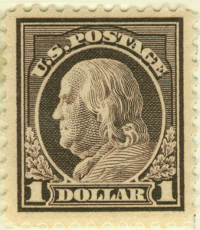
Discussion - Member to Member Sales - Research Center

Discussion - Member to Member Sales - Research Center

New to Great Britain stamps, so any help would be appreciated.
Mel

Login to Like
this post
It's not common, but fully perfed stamps have been sold in coil format. Great Britain, Denmark, and (I seem to recall, Germany have all issued such coils, which sometimes can be identified by blunted perfs on two opposite sides.
Bob

Login to Like
this post
Hi Everyone;
Is maybe the reason they are called coil stamps, because they are sold by the post office
in coiled up shape like a roll of tape?? They do not have to have straight edges in order to
be made into coils.
Just an idea....
TuskenRaider

Login to Like
this post
According to Google: "In the UK, coil stamps first appeared in 1907, to supply newly installed stamp vending machines. As these were cut from complete sheets, they are perforated on all four sides. As each stamp was worth either a half or one old penny and 240 pence made up one pound sterling, the coils were in rolls of 960 or 480 each."
This Guide to the Admiral Stamps of Canada provides some interesting information.
This image shows that these U.S. stamps were printed in sheet form, and fully perforated, with a plan to sell them as coil stamps:

Images of New Zealnd coil stamps:


I've never concentrated on coil stamps, so I'm afraid that I can't tell you how to ID fully perfed coil stamps, although some are no doubt different in some way from the same stamps sold in sheets. Other members probably know a lot more about coil stamps than I do.
Bob

Login to Like
this post
German coils will have a control number on every 5th stamp in the coil.

Note the rough perfs common with coil stamps perfed on all four sides. The same is true with booklet panes made from sheet stamps. The perfs along the edges of the booklet pane are often cut.

Login to Like
this post
Again, thanks for the information. It is starting to make some sense. Another possible way is that the WM is sideways. Accordingly, Scott #187 is normal while the Scott #187a with a sideways WM is identified as a "Coil Stamp", at least in my Scott Great Britain Album. Could be when they made them into coil rolls, the WM appeared sideways after the stamps were separated, but that does not explain the Scott 177 -178 being called "Coil Stamps." The mystery continues.
Anyway this is all new territory as I venture into the realm of foreign stamps.
Mel

Login to Like
this post
According to Gibbons, Scott #177-178 were originally issued in rolls (vertical coils). It has been discovered that they were later also issued in sheet format. If you find these stamps in horizontal multiples (pairs and blocks), they are considerably rare. Also the 1913 coil stamps were issued on different watermarked paper (Scott Watermark #32 than the 1912-1924 regular issue (Scott Watermark #33).

Login to Like
this post
Thanks, Michael and others
I was looking in the wrong place in my Gibbons. I was matching Scott# 177 and 178 with SG 351 and 357. If I had continued looking would have found that Scott #177 and 178 are SG 397 and 398. I knew about the WM, but was confused by the term "Coil Stamp". Gibbons, as Michael said tells me that those stamps were originally issued in rolls, which would make them "Coil"
Learn something new everyday. And I thought the W/F were hard.

Login to Like
this post

Approvals
OK, now I am confused. Great Britain Scott #177 and 178 are perf 15X14, but are labeled "Coil Stamps" Believe they are SG #351 and 357. To me coil stamps are only perfed on 2 sides, either vertical or horizontal. How can these stamps be perf 15X14 and be called coil stamps. What am I missing?
New to Great Britain stamps, so any help would be appreciated.
Mel

Login to Like
this post

re: Help With ID
It's not common, but fully perfed stamps have been sold in coil format. Great Britain, Denmark, and (I seem to recall, Germany have all issued such coils, which sometimes can be identified by blunted perfs on two opposite sides.
Bob

Login to Like
this post

re: Help With ID
Hi Everyone;
Is maybe the reason they are called coil stamps, because they are sold by the post office
in coiled up shape like a roll of tape?? They do not have to have straight edges in order to
be made into coils.
Just an idea....
TuskenRaider

Login to Like
this post

re: Help With ID
According to Google: "In the UK, coil stamps first appeared in 1907, to supply newly installed stamp vending machines. As these were cut from complete sheets, they are perforated on all four sides. As each stamp was worth either a half or one old penny and 240 pence made up one pound sterling, the coils were in rolls of 960 or 480 each."
This Guide to the Admiral Stamps of Canada provides some interesting information.
This image shows that these U.S. stamps were printed in sheet form, and fully perforated, with a plan to sell them as coil stamps:

Images of New Zealnd coil stamps:


I've never concentrated on coil stamps, so I'm afraid that I can't tell you how to ID fully perfed coil stamps, although some are no doubt different in some way from the same stamps sold in sheets. Other members probably know a lot more about coil stamps than I do.
Bob

Login to Like
this post

re: Help With ID
German coils will have a control number on every 5th stamp in the coil.

Note the rough perfs common with coil stamps perfed on all four sides. The same is true with booklet panes made from sheet stamps. The perfs along the edges of the booklet pane are often cut.

Login to Like
this post

Approvals
re: Help With ID
Again, thanks for the information. It is starting to make some sense. Another possible way is that the WM is sideways. Accordingly, Scott #187 is normal while the Scott #187a with a sideways WM is identified as a "Coil Stamp", at least in my Scott Great Britain Album. Could be when they made them into coil rolls, the WM appeared sideways after the stamps were separated, but that does not explain the Scott 177 -178 being called "Coil Stamps." The mystery continues.
Anyway this is all new territory as I venture into the realm of foreign stamps.
Mel

Login to Like
this post

re: Help With ID
According to Gibbons, Scott #177-178 were originally issued in rolls (vertical coils). It has been discovered that they were later also issued in sheet format. If you find these stamps in horizontal multiples (pairs and blocks), they are considerably rare. Also the 1913 coil stamps were issued on different watermarked paper (Scott Watermark #32 than the 1912-1924 regular issue (Scott Watermark #33).

Login to Like
this post

Approvals
re: Help With ID
Thanks, Michael and others
I was looking in the wrong place in my Gibbons. I was matching Scott# 177 and 178 with SG 351 and 357. If I had continued looking would have found that Scott #177 and 178 are SG 397 and 398. I knew about the WM, but was confused by the term "Coil Stamp". Gibbons, as Michael said tells me that those stamps were originally issued in rolls, which would make them "Coil"
Learn something new everyday. And I thought the W/F were hard.

Login to Like
this post

